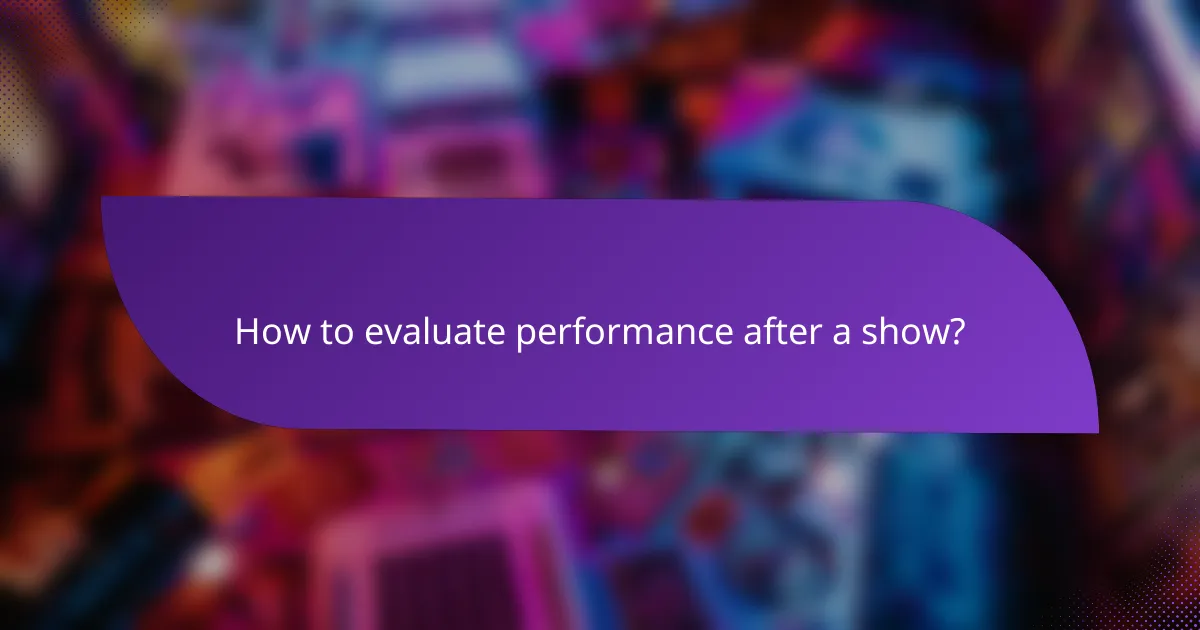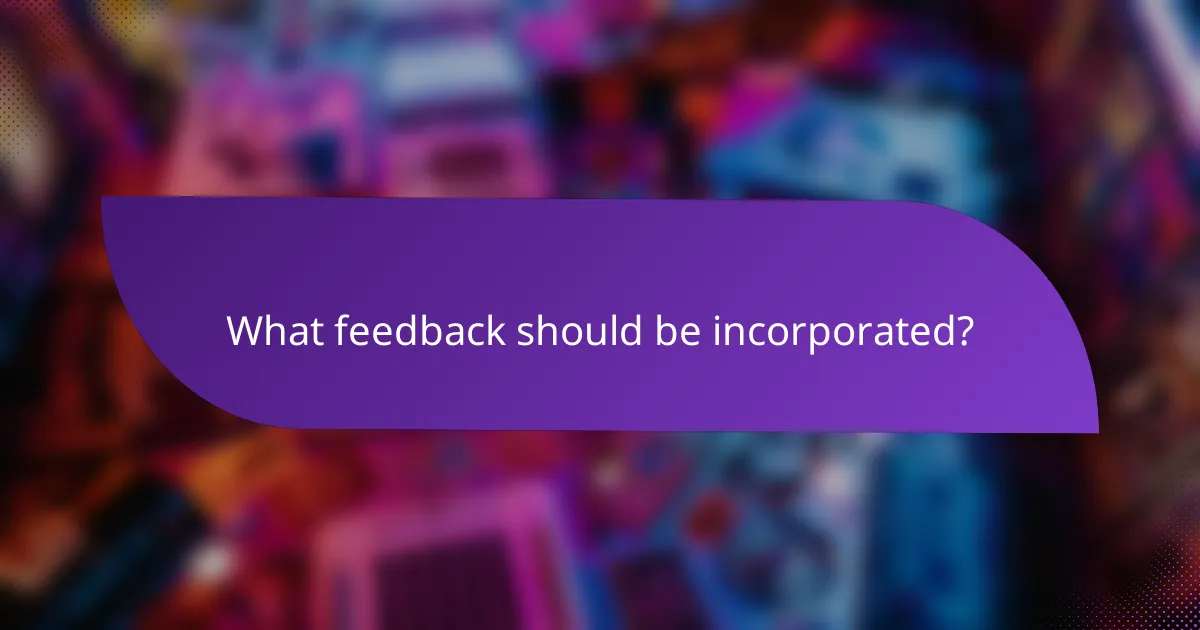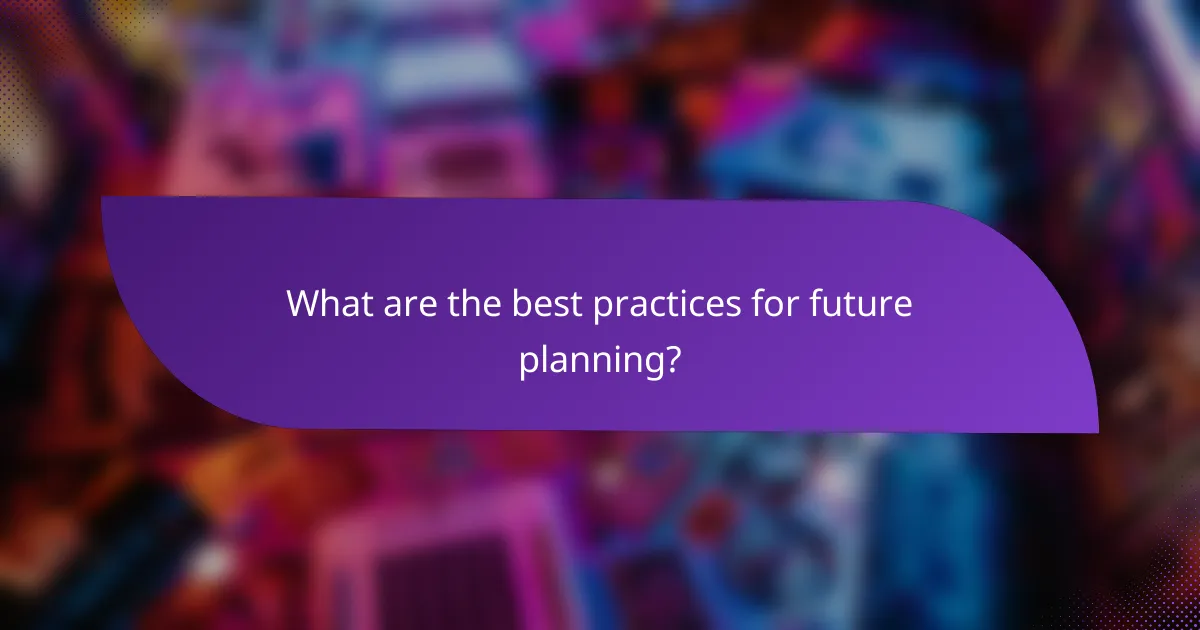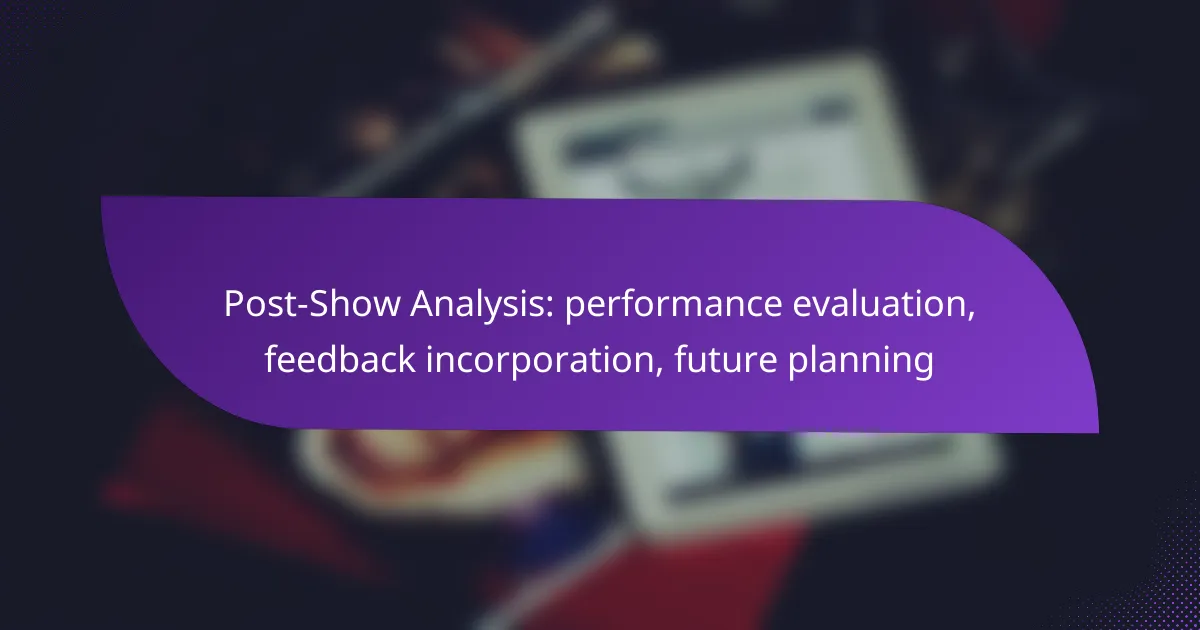Post-show analysis is vital for understanding the effectiveness of a performance and identifying areas for improvement. By evaluating various metrics and incorporating feedback from audiences and staff, organizers can enhance future events. This strategic approach not only aids in setting clear objectives but also ensures that resources are allocated effectively to create engaging experiences.

How to evaluate performance after a show?
Evaluating performance after a show involves analyzing various metrics to understand its success and areas for improvement. This process is crucial for enhancing future events and ensuring that objectives are met.
Key performance indicators (KPIs)
Key performance indicators (KPIs) are measurable values that demonstrate how effectively a show meets its objectives. Common KPIs include ticket sales, attendance numbers, and audience satisfaction ratings. Establishing clear KPIs before the show can help in assessing its overall success.
For example, if the goal was to sell 500 tickets, achieving this target or exceeding it would indicate a successful performance. Regularly reviewing these indicators helps in making informed decisions for future shows.
Audience engagement metrics
Audience engagement metrics gauge how actively attendees interacted with the show. This can include social media mentions, audience participation during the event, and post-show surveys. High engagement often correlates with a positive experience and can lead to increased loyalty.
Tracking metrics such as social media shares or comments can provide insights into audience sentiment. Engaging with attendees through polls or Q&A sessions during the show can also enhance this metric.
Sales conversion rates
Sales conversion rates measure the percentage of potential customers who made a purchase during or after the show. This metric is vital for understanding the effectiveness of marketing efforts and the appeal of the offerings presented. A conversion rate of 20-30% is generally considered strong in event settings.
To improve conversion rates, consider offering limited-time discounts or exclusive merchandise during the show. Analyzing the sales funnel can help identify where potential customers dropped off.
Feedback collection methods
Collecting feedback is essential for understanding audience perceptions and improving future shows. Common methods include post-event surveys, direct interviews, and social media feedback. Utilizing a mix of quantitative and qualitative approaches can yield comprehensive insights.
For instance, a simple online survey sent via email can capture attendee satisfaction ratings, while open-ended questions can provide deeper insights into their experiences. Ensure that feedback collection is easy and incentivize participation to increase response rates.
Comparative analysis with previous shows
Comparative analysis involves evaluating the current show against past performances to identify trends and areas for improvement. This can include comparing KPIs, audience engagement, and feedback scores. Recognizing patterns over time can inform strategic decisions for future events.
For example, if attendance has consistently increased year-over-year, this may indicate successful marketing strategies. Conversely, if audience engagement metrics decline, it may prompt a reevaluation of content or format.

What feedback should be incorporated?
Incorporating feedback is essential for improving future performances. Key sources of feedback include audience surveys, staff insights, social media sentiment, and post-event discussions, each providing unique perspectives that can enhance planning and execution.
Audience surveys and testimonials
Audience surveys and testimonials are vital for understanding the attendees’ experiences and perceptions. Surveys can be distributed immediately after the event, focusing on aspects like content quality, engagement levels, and overall satisfaction. Aim for a response rate of at least 20-30% to gather meaningful data.
Testimonials can be collected through open-ended questions, allowing attendees to share their thoughts in their own words. Highlighting positive feedback in marketing materials can also help attract future audiences.
Staff insights and observations
Staff insights and observations provide an internal perspective on the event’s execution. Encourage team members to share their experiences, noting what worked well and what could be improved. This can be done through informal discussions or structured feedback forms.
Consider conducting a brief meeting post-event to gather these insights. Focus on areas such as logistics, audience engagement, and technical execution to identify actionable improvements for future events.
Social media sentiment analysis
Social media sentiment analysis helps gauge public perception of the event. Monitor platforms like Twitter, Facebook, and Instagram for mentions and comments related to the performance. Tools like sentiment analysis software can quantify positive, neutral, and negative feedback.
Look for common themes in the posts, such as specific highlights or areas of concern. This analysis can guide adjustments in marketing strategies and content for future events, ensuring alignment with audience expectations.
Post-event debrief discussions
Post-event debrief discussions are crucial for synthesizing feedback from various sources. Gather key stakeholders, including staff and volunteers, to review the event’s successes and challenges. This collaborative approach fosters a culture of continuous improvement.
During the debrief, create a list of actionable items based on the feedback received. Prioritize these items to focus on the most impactful changes for future performances, ensuring that lessons learned are effectively integrated into planning processes.

What are the best practices for future planning?
Effective future planning for shows involves setting clear objectives, managing budgets wisely, selecting appropriate venues, and utilizing technology to enhance audience engagement. These practices help ensure that each event is successful and meets its intended goals.
Setting clear objectives for future shows
Establishing clear objectives is crucial for guiding the planning process of future shows. Objectives should be specific, measurable, achievable, relevant, and time-bound (SMART) to provide a solid framework for success. For instance, aiming to increase attendance by a certain percentage or enhancing audience satisfaction ratings can help focus efforts.
Involve key stakeholders in the objective-setting process to ensure alignment and buy-in. Regularly review and adjust these objectives based on feedback and performance metrics from past events to stay on track.
Budget allocation strategies
Effective budget allocation is essential for maximizing the impact of your show. Begin by analyzing previous budgets to identify areas of overspending or underspending, and allocate funds based on past performance and future objectives. Consider setting aside a contingency fund of around 10-15% of the total budget to cover unexpected expenses.
Break down the budget into categories such as venue costs, marketing, technology, and staffing. This approach allows for better tracking and adjustments as needed. Prioritize spending on elements that directly enhance the attendee experience, as this can lead to higher satisfaction and repeat attendance.
Choosing the right venues
Selecting the right venue is a key factor in the success of any show. Consider the venue’s capacity, location, accessibility, and amenities when making your choice. A venue that is easily accessible via public transport can significantly increase attendance, while one that offers modern facilities can enhance the overall experience.
Evaluate potential venues by visiting them in person and assessing their suitability for your specific needs. Compare rental costs, available dates, and any additional services provided, such as catering or technical support, to make an informed decision.
Leveraging technology for engagement
Utilizing technology can greatly enhance audience engagement during shows. Consider incorporating interactive elements such as live polls, Q&A sessions, or social media integration to encourage participation. Tools like event apps can provide attendees with schedules, speaker information, and networking opportunities at their fingertips.
Invest in high-quality audiovisual equipment to ensure that presentations are clear and engaging. Additionally, consider using data analytics to track attendee behavior and preferences, allowing for more tailored experiences in future events.

How to create a post-show report?
A post-show report summarizes the performance evaluation, feedback incorporation, and future planning based on a recent event. It serves as a crucial tool for assessing outcomes and guiding improvements for future shows.
Components of an effective report
An effective post-show report should include key components such as an overview of the event, performance metrics, audience feedback, and actionable recommendations. Start with a brief summary that captures the essence of the show, followed by detailed sections that analyze specific aspects.
Performance metrics might include ticket sales, attendance figures, and audience engagement levels. Incorporating qualitative feedback from attendees can provide insights into their experiences and highlight areas for improvement.
Finally, actionable recommendations should be clear and prioritized based on the analysis. This helps stakeholders understand the next steps and focus on what will enhance future performances.
Visual data presentation techniques
Visual data presentation is essential for effectively communicating insights in a post-show report. Use graphs, charts, and tables to represent performance metrics and audience feedback, making the information easily digestible.
For instance, bar charts can illustrate ticket sales trends over time, while pie charts can show audience demographics. Tables can effectively summarize qualitative feedback, allowing for quick comparisons between different aspects of the show.
Ensure that visuals are clear and labeled appropriately. Avoid clutter and focus on key data points that support your conclusions. This will enhance understanding and retention of the information presented in the report.
